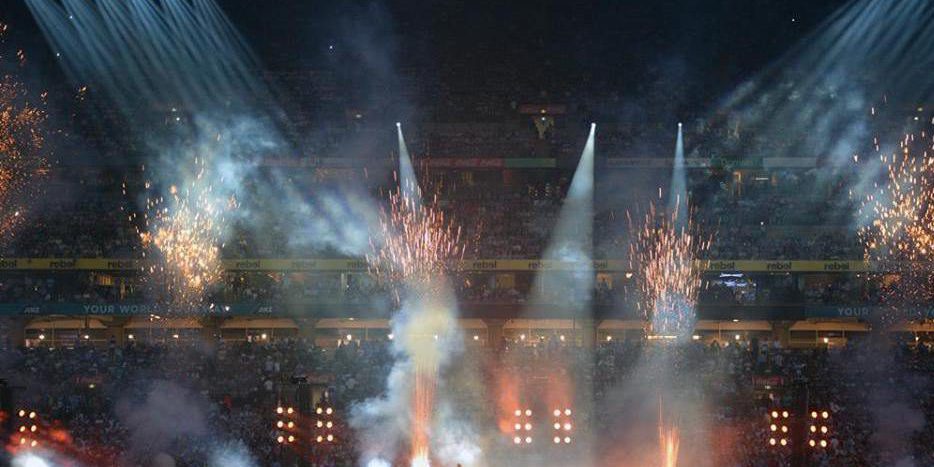Lighting designer Tom Wright had the difficult task of lighting the pre-match entertainment at this year’s NRL Grand Final at Sydney’s ANZ Stadium. Fortunately, he had done the job before, as well as several State of Origins, and knew how to overcome the complexities associated with the production.
“You never really know where you are until one to two weeks out,” he admitted. “I have to give huge thanks to the Chameleon Touring Systems team for riding that with me. Chameleon’s Luke Cuthbertson is one of the calmest account managers I have ever worked with! I think I sent seven versions of the plot and the seventh was only a week before the event.”
Tom designed a backdrop which consisted of five ‘Towers of Power’ that resembled medieval catapults being pushed onto the field. They sprung erect to backlight the stage area and add height to the lighting. The structures rose from flat to 45 degrees, then raised again, on cue, to almost vertical.
Constructed by Stageset, each Tower was faced with ten ShowPro LED GoldenEYE 77 panels to produce a huge shaft of blinding light. They also had content played though them to give shape and movement to the back of camera shots. Each Tower also had twelve Martin MAC Aura’s (Aura XB’s on the outside and normal inside) rigged in a box configuration to mirror stadium light towers.
“My biggest concern with the Towers was weight especially as I wanted to put as much lighting as possible on them,” added Tom. “I knew the Aura XB’s were insanely bright and would work well. They also have nice looking faces which was important.”
Richie Sambora’s stage and performance was in daylight and so Tom placed four Clay Paky B-EYE K20 fixtures behind him and four Sunstrips to uplight the performers. Eight GoldenEYE 77 panels were placed upstage to create a cross pattern so whether Richie was shot from the left or right, there was always a panel in camera shot.
Keith Urban’s main stage housed twenty Clay Paky B-EYE K20, a fixture that Tom says always looks good on camera.
“Keith likes big swathes of colour such as all orange or all blue,” explained Tom. “We knew if we had the B-EYEs as well as GLP impression X4 Bar 20s, we’d get nice big curtains of light over the stage whilst still able to have beams. I didn’t want any fixtures onstage that needed to be striked as you often find the stage is the last to get power and the last thing you want to do is be sending strike commands to the stage just as you are about to start. The crew hate having dimmers on these gigs; there’s a hell of a lot of cabling, and a lot more fault finding to do. So I tend to use Sunstrips to light up the performers although I put a massive amount of frost on them so there isn’t a hotspot of light pointing at someone’s chin.”
Tom was particularly impressed by the GLP impression X4 Bars, describing them as fast, responsive and capable of delivering great colours.
“When you put them into the tight 2° beam they are awesome.” He said. “Keith has something like 270 on his current tour, I was only able to offer him 20! We put them in a criss-cross configuration on the stage knowing that if you tilted them forward, you would always hit someone on stage.”
With so many LED fixtures onstage Tom wanted something tungsten for the cameras and so he added thirty-six Elidy panels pointing in random directions so the camera would always pick up something.
Twenty-four Martin MAC Viper AirFX were hung from roof trusses (six per truss) to project patterns onto the stage and Tom was amazed by their long throw. Everything else that was not the main show – such as Jessica Mauboy’s solo performance and Dami In’s national anthem – was lit entirely by the MAC Viper AirFX. And when the pyro smoke got heavy towards the end of the show, the MAC Viper AirFX cut through like no other fixture could.
Twenty Clay Paky Mythos were rolled onto the field mainly behind the stage from where they could fill wide shots.
“You don’t do much creativity with them, you just point them in nice pretty patterns into the sky and they just perform,” Tom said. “You only need to put them in a classic fan and they look incredible. I also like to shoot them across the field in a criss-cross effect. It looks spectacular if you don’t put a pan effect through it, you just see a changing pattern of light on the field and it looks huge.”
Normally Tom would only install four follow spots into ANZ Stadium but due, to the increased number of performers on stage, he increased this to six; four always on Keith and two for his two guitarists. For the key moments in his duet with Jessica Mauboy, all six were put onto them.
“I chose Robert Juliat Cyrano follow spots as they are bright and so easy to use,” Tom said. “In fact the crew just walked up there and had them operating without any instruction from me. They’re smooth and for such a low wattage, you would mistake them for something twice as powerful.”
For control Tom used an MA Lighting set up of two grandMA2 light consoles, two MA NPU Nodes, and four MA NSP Nodes.
“MA2 is the leader and you wouldn’t choose anything else,” he commented. “There’s no way you can do some of the networking on any other consoles that I know of, to that level of stability and security. I knew I could work in the pre-viz suite, take a show file, load it into the console and it would just work.”
Fortunately for Tom, Chameleon Touring Systems’ managing director Tony Davis is a big Cronulla Sharks fan and as such, was somewhat generous with his supply of lighting!

